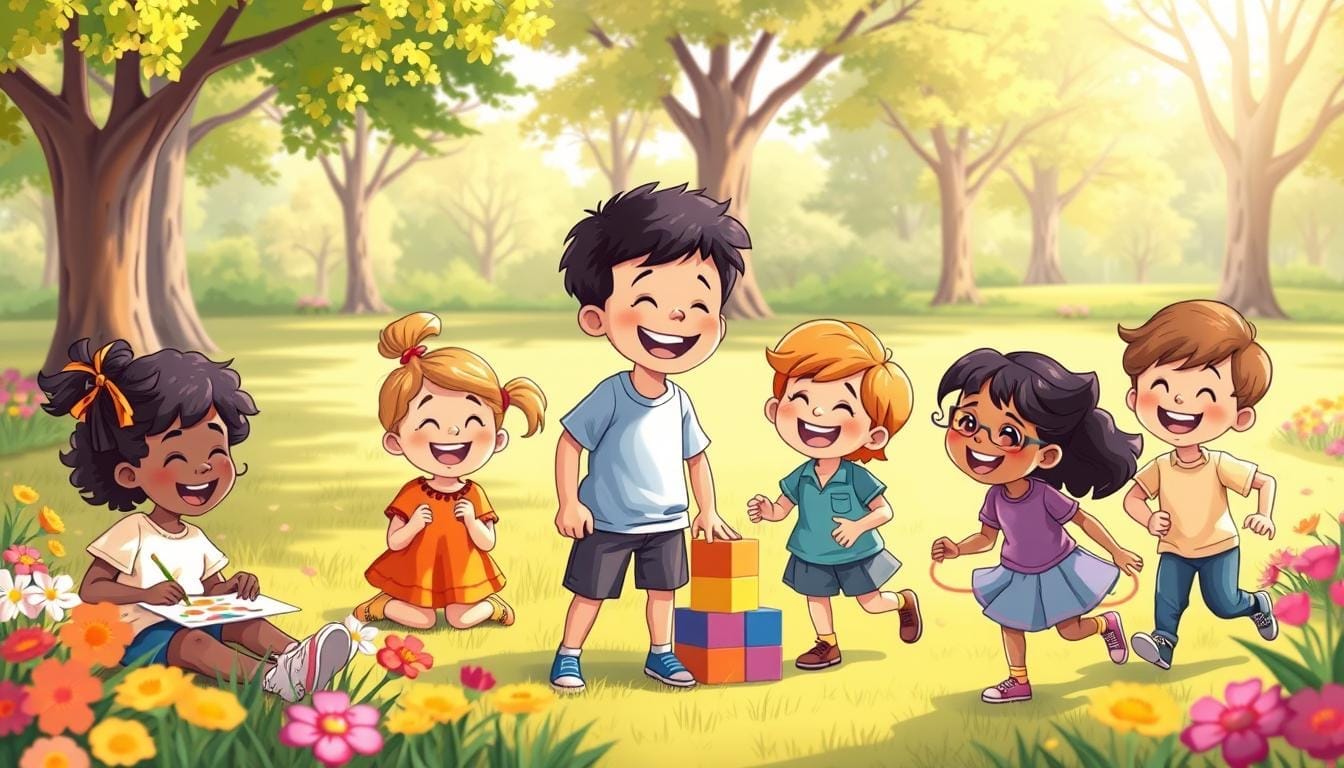Storytelling is a key tool in child development psychology. It helps grow young minds in many ways. Kids learn new words and understand the world better through stories.
Studies show that stories keep kids’ brains active longer than just looking at pictures. This makes storytelling a special way to help kids think, feel, and speak better.
We will look at how storytelling has helped kids for a long time. It boosts their thinking, feelings, and speaking skills. By using stories, we can help kids learn and grow in amazing ways.
Table of Contents
ToggleIntroduction to Storytelling and Its Importance
Storytelling is a special art that uses words and actions to share stories. It makes the listener use their imagination. Unlike reading books, it doesn’t need printed materials and involves looking directly at the listener.
Child development psychology studies how kids grow from babies to teenagers. It finds that storytelling is key for their growth in many ways.
Definition of Storytelling
Storytelling is the art of telling stories with words, voice, and body. It lets the storyteller and the listeners work together to understand the story. This makes storytelling a dynamic and interactive experience.
Overview of Child Development Psychology
Child development psychology looks at how kids and teens change. It covers many areas like thinking, speaking, feeling, and moving. Storytelling helps kids grow and learn as they reach different milestones.
Studies show storytelling affects kids’ brains and development. Near-infrared spectroscopy (NIRS) shows kids’ brains work hard when they listen to stories. This shows storytelling’s impact on their minds and bodies.
Historical Context of Storytelling
Storytelling has been key to human culture for ages. It has crossed borders and changed with time. From old tales told by mouth to today’s digital stories, it has helped share values and history. Knowing how storytelling has changed helps us see its big role in growing kids.
Traditional Storytelling in Various Cultures
Different cultures have used stories to keep their identity alive. Elders would tell tales to kids, sharing their worldviews and traditions. These oral traditions helped pass down important cultural values.
Evolution of Storytelling Methods
Storytelling has changed a lot over time. It moved from just talking to writing and now to digital stories. The printing press made sharing stories easier. Today, stories include videos, games, and social media, reaching more kids than ever.
This change in how stories are told has greatly affected kids. From old tales to new digital ones, stories shape kids’ minds and hearts. They help kids learn and grow in many ways.
Cognitive Development Through Storytelling
Storytelling is key in shaping kids’ minds. Studies show that stories light up kids’ brains. They process language, emotions, and more.
This activity makes kids feel good. It helps them remember stories better.
Enhancing Language Skills
Stories introduce kids to new words and ways of speaking. A study in Developmental Psychology found a link. Kids who heard more complex stories did better in school.
Fostering Critical Thinking
Stories help kids think critically. They follow plots, understand characters, and guess what happens next. This sharpens their minds.
Stories teach kids to be strong and flexible. They learn to face challenges and adapt.
Storytelling does more than just improve language skills. It boosts social skills, creativity, and emotional understanding. Kids learn to see things from others’ viewpoints. This makes them more open and better communicators.
Emotional and Social Development
Storytelling is key for kids’ emotional and social growth. It lets them see different views and feelings through stories. This helps them understand and feel for others.
Building Empathy and Understanding
Stories let kids see things from different characters’ points of view. They feel their happiness, sadness, and struggles. This helps kids learn to care about others’ feelings.
By seeing things from others’ eyes, kids get a better grasp of life. They start to connect with their friends better.
Strengthening Social Skills
Stories also boost kids’ social skills. They learn to share, listen well, and share their thoughts. These skills help them make friends and deal with others.
Through stories, kids get better at talking, solving problems, and working together. This prepares them for life’s social challenges.
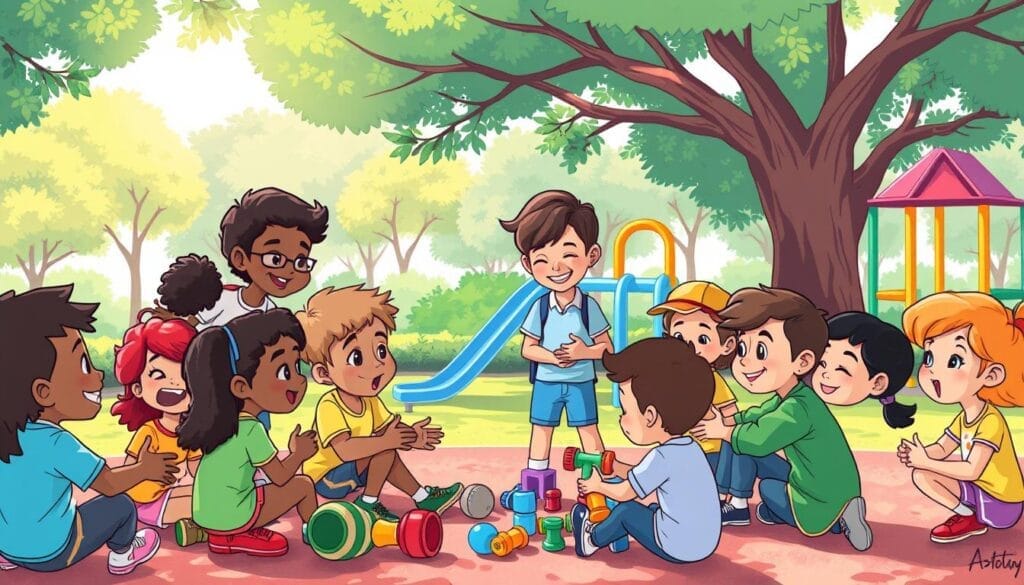
Storytelling as a Tool for Education
Storytelling makes learning fun and effective for kids. It helps teachers explain hard ideas in a way that’s easy to get. Studies show it really helps students learn better.
Engaging Young Learners
Stories grab the attention of young kids, making them excited to learn. Books can cut down on boredom in kids by up to 30%. Teachers use stories to teach new things, check if students get it, and encourage thinking.
Integrating Storytelling in Curriculums
Adding stories to lessons makes learning more fun. Stories fit into many subjects like history, science, and language. They help students remember and understand better because they connect ideas to stories.
Using stories in teaching makes learning fun and interactive. It boosts learning engagement, helps mix different subjects, and supports educational storytelling. This tool is great for growing young minds.
Benefits of Interactive Storytelling
Storytelling is great for kids, and interactive stories are even better. They make learning fun and help kids remember more. This is because they get to join in and learn by doing.
Participatory learning makes stories more exciting. It helps kids remember what they learn. This is because they are part of the story.
Encouraging Participation
Interactive stories let kids help tell the story. This makes them feel more creative and confident. They can guess what happens next or change the story a bit.
It turns them from just listening to being part of the story. They feel like they own the story.
Enhancing Retention and Recall
Studies say interactive stories help kids remember better. When they’re involved, they remember more. This is because they’re not just listening.
They’re part of the story. This makes learning stick with them longer.
Interactive stories mix fun with learning. They help kids grow smarter and more creative. They also build their confidence and happiness.
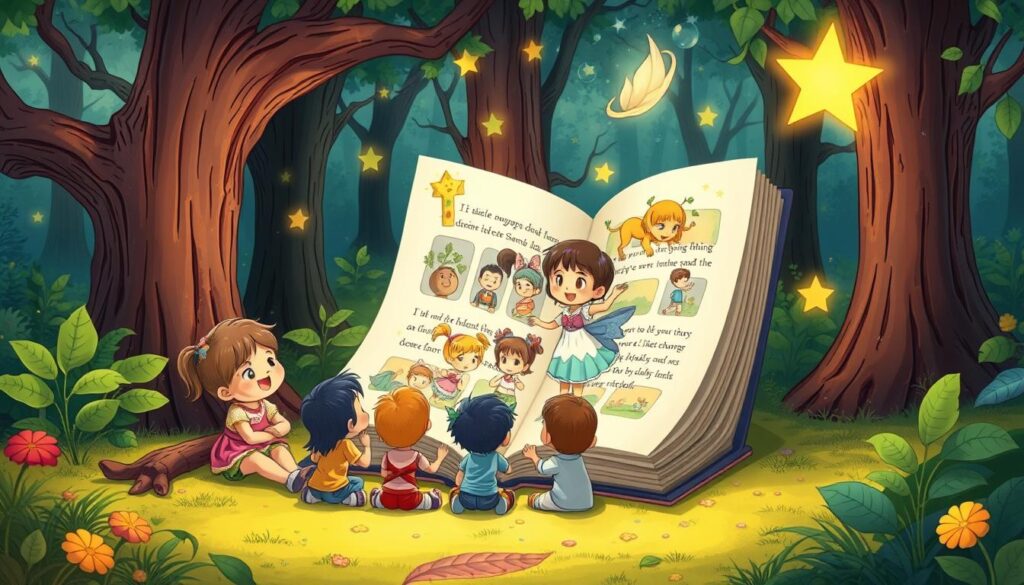
The Role of Parents and Caregivers
Parents and caregivers are key in helping children grow. Research shows that when moms talk more during book time, kids learn better. This helps kids read and understand books better as they get older.
Storytelling Practices in the Home
Storytelling at home is great for kids. It helps them learn to read and speak better. Parents can read books, tell stories, and let kids make up their own tales.
Encouraging Independent Story Creation
Letting kids tell their own stories is good for them. It makes them creative and helps them think critically. This way, kids learn and grow in a fun way.
The Abu Dhabi Early Childhood Authority (ECA) says storytelling is key for kids. Programs like the Anjal Z Program show how important it is. Tools like the Storybutton and Storytailor.ai help kids learn through stories.
Storytelling and Cultural Identity
Storytelling is very important for keeping cultural heritage alive. It helps children understand their roots and grow their identity. Stories from the past teach us about our values and traditions.
Preserving Heritage Through Stories
Storytelling helps pass down cultural knowledge and traditions. It connects children to their family’s history and traditions. This way, they learn to appreciate their cultural identity.
Influencing Identity Formation
Stories shape who we are. They help children understand their culture and place in the world. These stories teach us values and help us navigate our heritage.
Studies show family stories are good for kids. They help with social, emotional, and language skills. Using props or tech makes these stories more fun and memorable for kids.
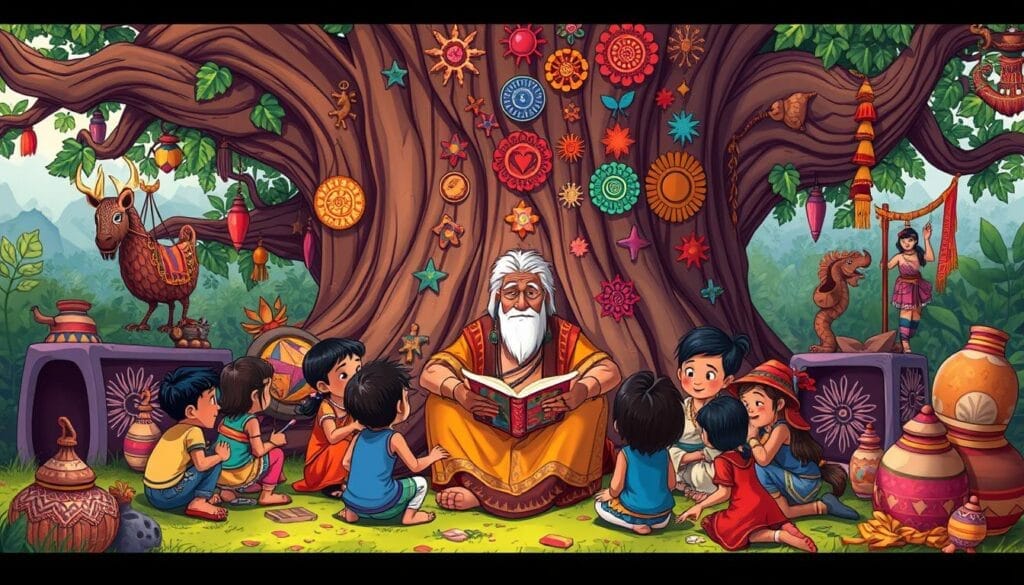
In short, storytelling is key for keeping culture alive and helping kids grow. It connects us to our past and shapes our identity. Storytelling is a powerful way to share our heritage with the next generation.
The Therapeutic Benefits of Storytelling
Storytelling is a key tool in child development psychology, especially in counseling. It lets kids share and deal with their feelings in a safe way. It connects their inner world with the outside.
Storytelling in Counseling Settings
In counseling, storytelling helps kids see their experiences in a new light. It lets therapists understand their thoughts, fears, and dreams. This way, therapists can offer support that really fits each child’s needs.
Enhancing Emotional Expression
Storytelling helps kids talk about their feelings. Studies show that listening to stories can lower stress hormones and boost love hormones. This helps kids feel and manage their emotions better.
Storytelling is a powerful tool in child development. It offers a safe space for kids to explore their feelings. This helps them grow stronger and more aware of themselves.
Digital Storytelling in Today’s Era
In today’s schools, digital storytelling is changing how we tell stories. It brings new ways to engage kids. With technology, stories can now be interactive and full of multimedia.
Impact of Technology on Storytelling
Technology has changed storytelling a lot. Now, kids can mix text, images, audio, and video in their stories. This makes stories more fun and interactive.
With tech, kids can help shape the story. They can choose what happens next. This makes them feel more connected to the story.
Balancing Traditional and Digital Approaches
Even with new tech, old ways of telling stories are still important. Live stories and props help kids grow. We should use tech to make stories better, not replace them.
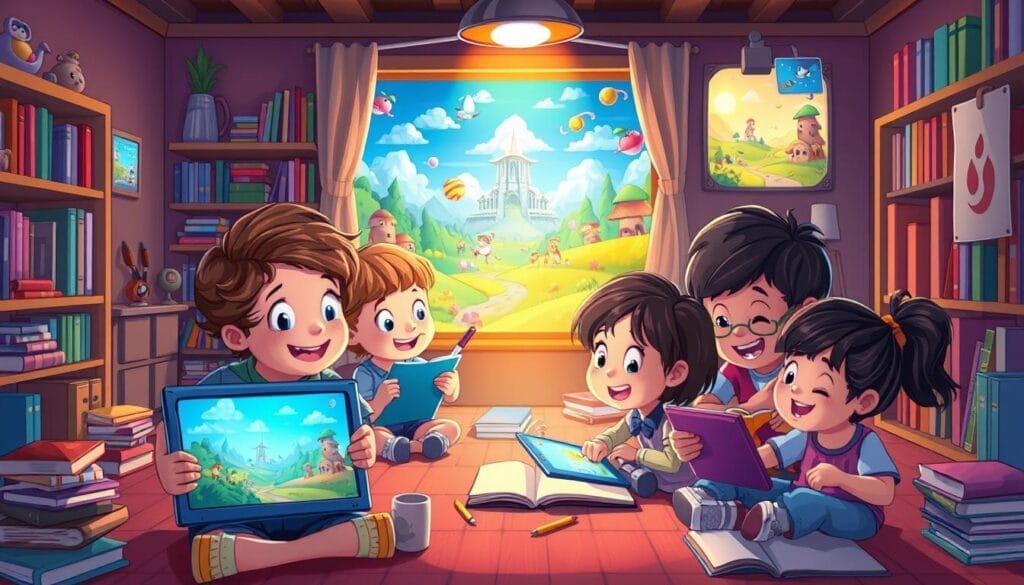
Teachers should mix old and new ways of telling stories. This way, every kid gets something they like. It makes sure stories are powerful and fun, without losing the magic of the past.
Practical Tips for Effective Storytelling
Storytelling is a great way to grab kids’ attention and help them grow. It can improve their language, thinking, and feelings. To make stories exciting, use different voices, gestures, and keep eye contact.
Techniques for Engaging Children
Storytelling is more than just telling a story. Ask questions to get kids thinking ahead. Let them join in and make the story their own. This makes them more interested and helps them think better.
Tailoring Stories to Audience Needs
Stories for kids should match their age and what they like. Wordless picture books are great for starting meaningful talks. Make sure the story fits the kids’ needs for the best learning.
Using these tips, adults can help kids grow in many ways. From making stories fun to matching them to what kids need, storytelling is key. It helps kids love learning and become well-rounded.
Conclusion: The Lasting Impact of Storytelling
Research shows that storytelling greatly impacts child development. It helps kids learn to read better in school. As research grows, we might learn more about digital stories and how they affect kids.
We could also find out how stories change in different cultures. And we might create special stories to help kids grow in different ways.
Summarizing Key Findings
Studies show that stories make kids’ brains work harder than just looking at pictures. This means stories are good for their minds.
Stories also help kids speak better, think more deeply, and feel empathy. They help kids understand their culture and learn new things.
Stories are great for getting kids excited about learning. They help teach important skills for today’s world.
Future Directions in Research and Practice
As we learn more about storytelling, we might study digital stories more. We could see how they compare to old-fashioned stories.
Looking into how stories change in different cultures could teach us a lot. Creating special stories for kids with certain needs could really help them grow.
For more on this, check out this link.
FAQ
What are the psychological and educational benefits of storytelling for children?
Storytelling boosts kids’ imagination and vocabulary. It also sharpens their communication skills. Studies show it keeps the brain active more than reading pictures.
How does storytelling differ from picture-book reading?
Storytelling uses words and actions to tell stories. It’s interactive and doesn’t need printed materials. It also involves eye contact with the audience.
How does storytelling impact cognitive development in children?
It improves language skills by introducing new words and sentence structures. It also encourages critical thinking. Kids who hear engaging stories early do better in school.
What are the emotional and social benefits of storytelling for children?
Storytelling helps kids understand different feelings and perspectives. It’s a safe space for exploring emotions. It also helps kids learn to listen and talk, improving their social skills.
How can storytelling be used as an educational tool?
Storytelling makes learning fun by making abstract ideas concrete. It’s great for all subjects, helping kids remember better. It can even make kindergarteners less bored.
What are the benefits of interactive storytelling?
Interactive storytelling gets kids involved, making learning more fun. It boosts their creativity and confidence. Kids remember stories they helped create better.
How do parents and caregivers influence storytelling practices at home?
Parents using complex language during reading boosts kids’ language skills. This leads to better reading and comprehension in school. Encouraging kids to tell their own stories also helps their language and creativity.
How does storytelling influence cultural identity and heritage?
Traditional stories keep cultural values alive. They give kids a sense of belonging and understanding of their roots. Storytelling is key in passing down cultural knowledge and shaping identity.
What are the therapeutic benefits of storytelling in child psychology?
Storytelling helps kids express and deal with emotions. It’s a safe way for them to talk about their feelings. It helps with emotional regulation and mental health.
How can digital storytelling be integrated with traditional storytelling methods?
Digital storytelling adds new dimensions to stories for kids. But, it’s important to balance it with traditional methods. Technology should enhance storytelling, not replace it.

Dr Chandril Chugh
Dr. Chandril Chugh, a renowned American Board-Certified Neurologist, is just a click away. With years of global experience, he offers trusted neurological guidance online.
→ Book a consultation to discover which remedies suit your needs best.




